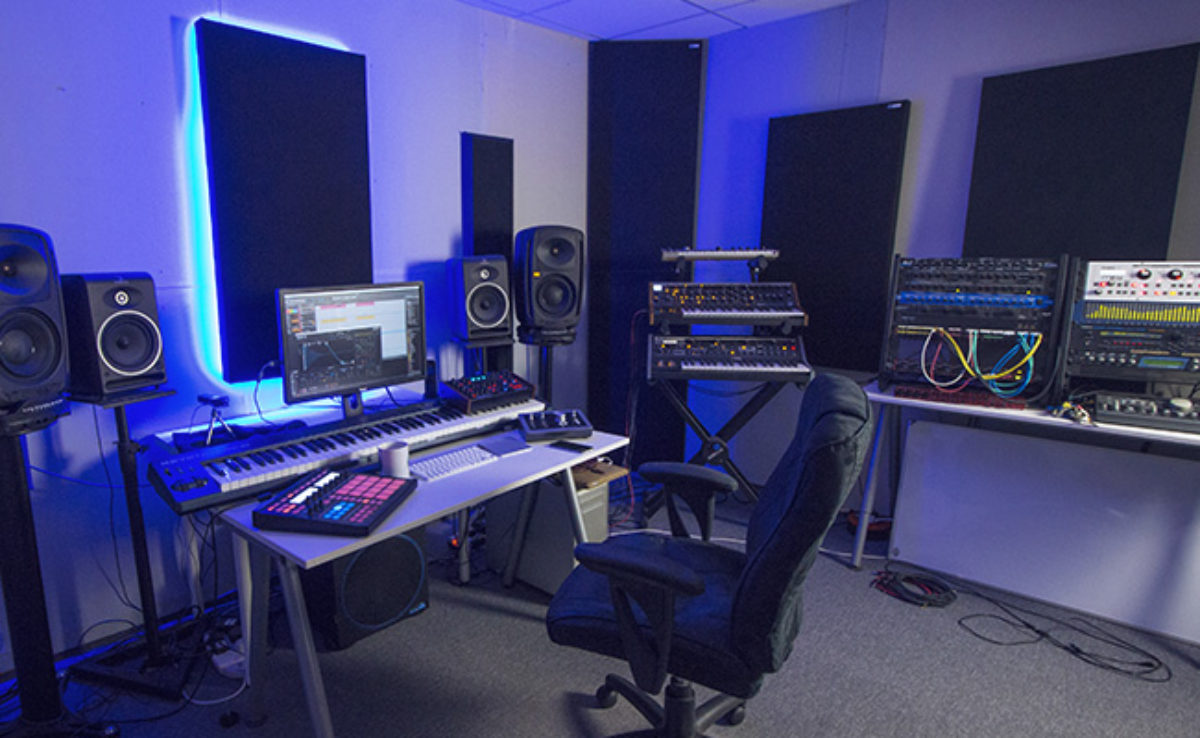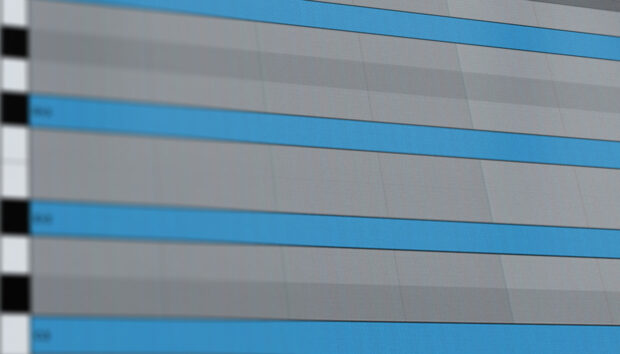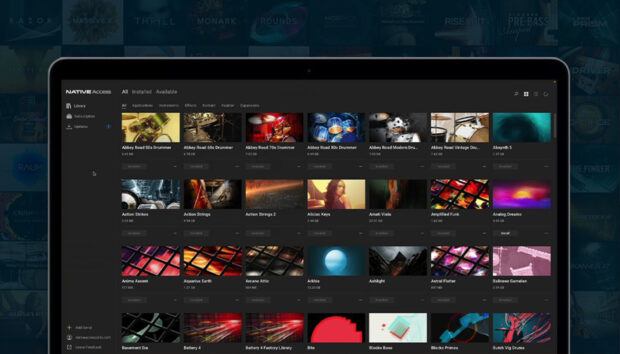
One of the brightest stars in the global house music firmament, Cardiff-based producer, engineer, DJ and sound designer Dom Kane divides his time between remixing and producing other artists, releasing his own cuts on deadmau5’ mau5trap label, and designing presets and samples for Xfer Records, FXpansion, Moog, and others. With his new EP, Structures, fresh out on mau5trap, we caught up with him to talk tech, education and new creative beginnings.
You’ve been in the game for a good few years – have you been making music since the pre-DAWs days, or did you come onboard when it was all possible in the box? What does your setup look like now?
I got into it around the same time as DAWs. I was a music nerd from birth, and luckily, my English teacher at school was into house music too. When he saw me playing with the school Casio keyboard and Atari computer one day, he gave me a Laurent Garnier cassette to listen to. He then started teaching me stuff about MIDI routing and recording in lunch breaks once a week. It was all MIDI trackers and 8-track tape recorders back then, so I guess that was essentially ‘the dawn of the DAW’.
Nowadays, Bitwig is absolutely my DAW of choice, and the team there are an incredible bunch of forward-thinkers.
How has your workflow changed, since you started out?
I think it’s actually gone almost full circle! I started out with basic kit and sloppy techniques, but as the technology has progressed over the years, it’s allowed the end-user to create a much more polished piece. So much so, that about five years ago, I got completely deflated with everything sounding so ‘perfect’, and that’s when I re-found my love for hardware and mistakes.
These days, I use a lot of my analogue synths to create the sounds, but I purposefully leave the latency in there, and manually record in any automation by hand – and I never save the preset, either. I find this a really liberating way of working now, because it forces me to move on to the next stage of the production, and if I find myself wanting to tweak a sound later, I have to re-do the entire thing.
As music listeners, we’ve become accustomed to hearing humans playing music; if you listen to a band playing live, the drummer/vocalist/guitarist are never consistently in sync like a drum machine and synth, so I find that some mistakes can add a more human element to electronic music.
Are there any key bits of kit, plugins or applications that you just couldn’t live without?
There’s no way I could make the music I do without my Moog Sub 37, not just because of the sound but because of the layout/workflow, too. I think Native Instruments Razor would probably come a close second in the synth world, and Serum and ANA 2. I think a lot of it comes down to familiarity, but it’s a rare occasion where something new comes out and blows everything out of the water. NI have been incredibly consistent in this, from the earlier stuff like Massive and FM8 – which were fundamental to what I did for years – and even their smaller effects like Solid Dynamics, Transient Master, or the new Choral/Flair/Phasis.
I’m an obsessive audio nerd so I can’t help myself from getting neck-deep in everything I do!
Like many professional producers these days, your output is very diverse – sound design, engineering, plus artist releases. Would you recommend everyone take this approach? Does it require a special skillset?
I’d only recommend it if it’s something you want to do. I don’t think that one necessarily helps the other, but I’m an obsessive audio nerd so I can’t help myself from getting neck-deep in everything I do! I started out as a producer and DJ, but it was sound design curiosity that lead me there, and that never went away. Eventually, having already carved a career out with plenty of releases under my belt, and residencies at places like Ministry Of Sound, and Space, I decided I wanted to learn the science behind the knobs I was twiddling, so I signed up for a maths/physics-based audio engineering degree.
I think each sector of the music industry requires a somewhat unique skillset, but there’s also an overlap between them. I just know I love trying new things and learning new techniques, and I’m a fan of all sorts of genres.
How did you learn your trade? At one point, it was all about starting as a tea boy at a big studio and working your way up, but those days are long gone. There are countless production degree courses available now – do you think they’re worth the time and money?
In all honesty, even though it doesn’t feel like that long ago, the entire world is a very different place now compared to when I first started. I started learning on an Atari ST, with 8-track tape recorders, etc., which meant I was fortunate enough to be on the front line when the internet came along. Back then, if you were able to release a record, there were people/labels investing real money and time into your work, whereas nowadays most of that quality control has gone. Most of the last decade has been so focused on social media and internet fame, that quality and skills have become almost irrelevant.
Having said that, I do think that era has peaked now, and I’m genuinely excited about what could be around the corner. Again, technology has helped here; much like where I was talking about my production workflow going full circle, I feel like we’re slowly passing a point now where music is being curated properly and the technology is allowing people’s artistic skills to be recognised again.
In terms of music education, that’s a tricky one. The vast majority of music production courses I’ve seen are really poorly put together cash-cows, offering to teach you how to beat-match or build a website. If you’re looking to gain a career in the music industry, you need to realise that a degree is unlikely to help. I did my degree at age 26, and there were literally hundreds of 18-year-olds there who wanted to be ‘famous’ music producers. The vast majority of them jumped ship in the second year, when they realised how much maths/physics/electronics was involved. In fact, only seven of us finished the degree.
It’s still a crowded market out there, but the vast majority of them are looking for instant fame and success, so you need to get in there with a long-term goal. Overnight success can happen to anyone at any time, but you can’t plan for that.
You’re working on a live show for this summer. Have you done one before? What kind of planning and equipment does that entail?
Yeah, I’m actually quite scared! I stopped using CD decks for DJing about ten years ago and started doing laptop sets, and it grew and grew to the point where I had two iPads, Maschine, a keyboard and a MIDI controller, with about four audio channels, four VST channels, and a whole host of FX. However, I wouldn’t have called that a full live show, really, and I kinda struggled mentally with the performance side of things. I remember being in the middle of a set in Pacha London, and thinking, ‘Does anyone actually know or care what I’m doing here? For all they know, I could be checking my Facebook’. But again, I think technology has progressed, and the integration of outboard gear has developed to a point where it’s a bit more viable to actually be playing things on the fly.
It’s still really early days yet, but I’ve started building the framework for [the show] in Bitwig and working out how best to play my own music live. Obviously, I can’t stand there creating a kick drum for 30 minutes, but I want it to be as involved as possible, so I’m even looking at having a session musician with me to help add to that.
On top of my Moog, and perhaps one or two others, I’m definitely going to need a custom MIDI controller, which I’ll start to design once myself I’ve nailed the Bitwig side of things.

What sets it apart from a DJ set?
That’s exactly the mental battle I’m going through at the moment. At the end of the day, there are people out there that pay silly amounts of money to watch an artist mime to their own recordings, so I don’t think it’s even about what other people think of it. For me, it’s about what I want it to be. As I said earlier, you can’t stand there and develop the sound design from scratch in a live scenario, but at the same time, I don’t think I could stand there and just press a play button, because that would bore me.
Tell us about the new Structures EP. How did it come about and how did you go about making it? How much did knowing the label, mau5trap, affect your creative/thought process and approach?
It had been in the pipeline for years, really. There was a period where the music scene had become so monotonous and generic that I felt completely deflated and uninspired. It was all the same ‘deep house’ and ‘EDM’ everywhere I went – just copy/paste music, which I’ve never been interested in. I stopped taking on new gig bookings, switched off my promo email address, unfollowed anyone I wasn’t personally friends with on social media, and just focused on the sound design and studio engineering side of my career. It took about 18 months before I opened up a DAW for myself, and that was off the back of playing with a Moog and Razor, processed through a Kyma Pacarana.
By this time, I’d lost touch completely with what was going on outside my own bubble, and just started to produce some tracks for the love of it. I ended up sending a few to my good friend Sonny Wharton for his opinion, and he replied saying that he felt that was exactly what the scene needed right now, so I gave them to him for his Whartone imprint. They did well, all charting on Traxsource, apparently, but I stayed shut off to the world and made a few more. Sonny suggested they may have a mau5trap feel about them, and since I already knew Joel (Deadmau5) and the team, I sent them there and they got signed up. This is really when I found my home as an artist. The team encourage creativity that doesn’t fit the generic mould, so there’s a lot of freedom for me to develop ideas.
The EP is called Structures, because I was thinking about the intricate layers within structures, from molecular to human relationships, and how repetition is required within the evolution of change. I don’t know if I got that across musically, but that was definitely my intention and inspiration. Knowing the label only affected my process in that I knew I could basically do anything I wanted. Believe it or not, that’s actually quite a difficult place to start!
On a related note, how do you creatively separate your various areas of operation: presets/sample collections, music for labels and music just for you?
I’m not necessarily one of those people that tries to make their sources mysterious. I set up a YouTube channel last year for me to nerd out over some of my production processes, and I’ve done courses for Future Music Magazine, Fader Pro, and Sonic Academy, so I don’t try and keep anything a secret. I know a few producers that have created sample packs and felt they were selling their soul, but I don’t see it like that at all. If someone bought one of my sample packs and made a number one hit with it, then props to them, because I didn’t manage to do that. However, I can sometimes feel a little uncreative in the studio, so playing with a synth, experimenting and creating presets can sometimes inspire me to write an entire track of my own. This doesn’t help with deadlines, but it certainly helps with my sanity.















